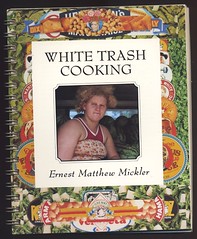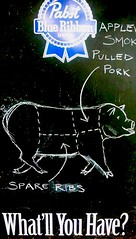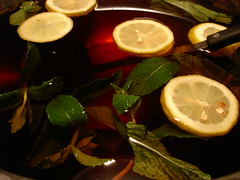As Easy as 3-2-1, rev. ed.
2013 was definitely the summer of ribs around here. We started with ribs (among other smoky delicacies, like brisket and sausages) back on a chilly afternoon in April when Szef Bartek and I kicked off our outdoor BBQ season,
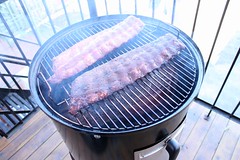 fig. a: ribs & brisket
fig. a: ribs & brisket
and the enthusiasm for baby backs and spare ribs never really abated. And now, with this incredible fall weather we've been having, the festival of smoke & ribs continues. It seems unlikely that it'll last much longer, but you never know. In the hopes that it will...
I've been making slow-smoked, ultra-tender "dry"-style ribs for a number of years now, and I've always been open to trying out new techniques--including "wet" styles--from time to time, but my "dry"-style ribs remained my preferred model. This year, however, I started working with a hybrid "competition"-style approach that appeared in Saveur's "BBQ Nation" issue a couple of years back (July 2011), and I really liked the results.
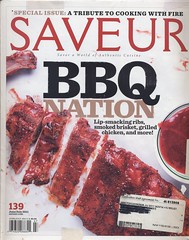 fig. b: BBQ nation
fig. b: BBQ nation
The method, which comes from a Richmond-based BBQ competition veteran named Tuffy Stone, starts "dry" (just dry rub, with a bit of misting), makes great use of a "crutch" (where you wrap or house your BBQ to accelerate the cooking process and add both moisture and flavour), and finishes "wet" (where sauce is used to baste the BBQ). I'd become a little more open to a "wet" finish because I'd finally developed a tomato-based barbecue sauce of my own that I was really happy with (one with plenty of bourbon in it), and I found that it married well with this "competition" approach.
The technique in question is what's known as the 3-2-1 approach. You can find all manner of commentary on this method throughout the most BBQ-obsessed regions of the Internet, but the essentials are pretty simple. Basically, once you've applied a dry rub to your ribs, you smoke them for three hours, misting them every 30 minutes; then you remove them from your smoker, slather them with a magic elixir, wrap them in foil, and put them back on your smoker for two hours; and, finally, you unwrap your ribs, and return them to the smoker for one hour, basting them with your BBQ sauce after 30 minutes. Hence, the 3-2-1.
In case you can't picture it, this is what they look like going into that final stage:
 fig. c: entering the final stage
fig. c: entering the final stage
If you can't tell, the results are fantastic. In fact, you might find dinner guests hoisting half-devoured ribs up into the air and proclaiming, "Now, THIS is what I call a rib!," after which they'll likely dip their rib into a little more sauce and finish the job--with gusto. My only caveat: make sure to make enough. I recommend a few racks if you're serving them as an appetizer to a crowd, and roughly half a rack each if you're serving them as a meal. Plus, you definitely want at least a few as leftovers.
 fig. d: leftovers! 1
fig. d: leftovers! 1
In fact, you might even want to think about having some for breakfast the next morning.
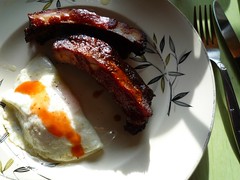 fig. e: leftovers! 2
fig. e: leftovers! 2
Definitely not the worst idea...
I've made variations on this method numerous times over the last several months, and I've found it foolproof. Well, maybe not exactly. Like all good barbecue, it takes some advanced planning and preparation and plenty of TLC.
A few pointers:
1. Maintaining a consistent heat, one suitable for slow-and-low smoking, is key to all great barbecue, of course. I like to keep things hovering around 225º throughout the entire process. You definitely don't need a fancy smoker to pull these ribs off. You don't even need a smoker at all--a good ole Weber barbecue will do the trick. It'll just require a little more attention to the heat on your part, and you'll have to be a little more clever when it comes to creating indirect heat.
2. Use an aromatic, complementary wood to smoke with. Stone recommends apple wood for his ribs; I'm partial to hickory.
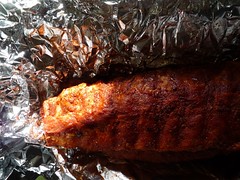 fig. f: rubbed
fig. f: rubbed
3. Stone's dry rub is excellent, but any kind that has a basis in sweet paprika, salt, black pepper, and brown sugar will work well here. His recipe recommends rubbing the ribs shortly before beginning to smoke them. I prefer rubbing them the night before to let the flavour sink in.
4. Mist the ribs with apple juice (following Stone's lead) or some kind of sweet & spicy vinegar-based concoction. Do so every 30 minutes for that first 3 hours.
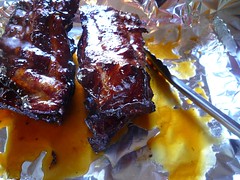 fig. g: drizzled
fig. g: drizzled
5. Stone's magic elixir that he drizzles his ribs with is a combination of butter, honey, and light brown sugar. I swear by the butter, but you can play around with the sweeteners. Maple syrup, for instance, is pretty ideal--and it also lends a little local/regional flavour to the mix.
6. Use a premium BBQ sauce to finish the ribs with, preferably one of your own design. Stone's, once again, is very good, but I'm partial to my bourbon-laced sauce.
Serve your ribs with your premium BBQ sauce and a vinegar-based BBQ sauce, if at all possible. Have plenty of BBQ-friendly sides on hand, too. I'm thinking cole slaw, baked beans, potato salad, and possibly even some corn bread.
Now dig in, and keep on smokin' in the free world!
aj








